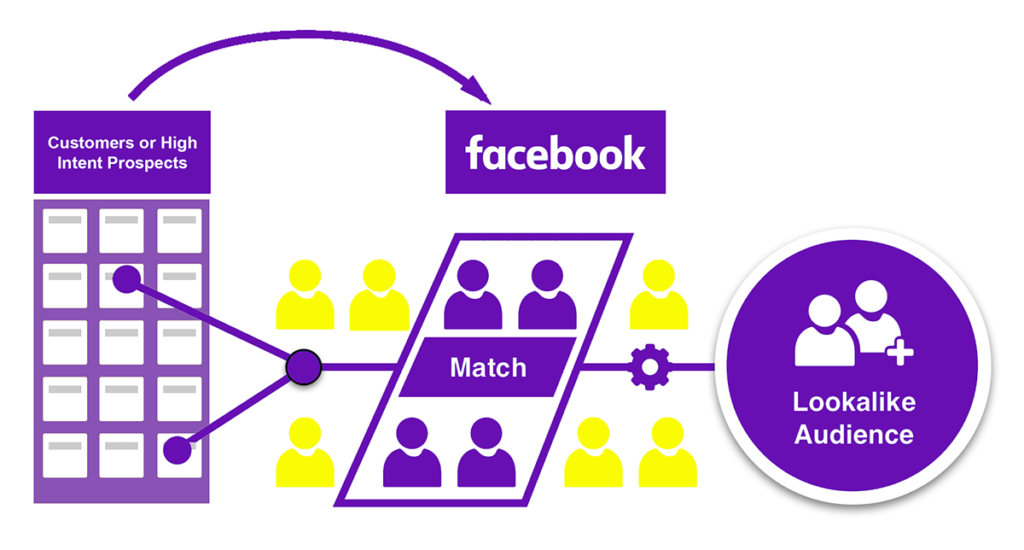Utilizing artificial intelligence and machine learning is nothing new in the digital marketing world. We’ve discussed it in broad detail with regards to AI marketing trends for 2020.
However, as big data continues to grow, both in its power and popularity, digital marketers need to consider two critical factors.
- How do I maximize results and efficiency?
- What should I automate, and what should I still do manually?
Leveraging Machine Learning Tools for Marketing
The benefits of using AI in digital marketing are pretty clear. Machines that can utilize deep learning are simply better and faster at crunching and organizing massive amounts of data. They help marketers identify trends and relationships, so we can make optimizations, and execute routine tasks.
Given what we know about how AI works and what it’s good at; below are some examples of machine learning tactics that marketers can take advantage of right now.
Audience Building

Artificial intelligence can take much of the guesswork out of targeting. While it may be true that your target audience over-indexes among sports fans, not everyone that goes to ESPN.com is a potential customer – not to mention the expensive premiums that go with targeting specific sites directly.
Honing in on your targeting based on the audience rather than site is the basis for programmatic advertising, and it all starts with AI tools.
In-Market Audiences – Google looks at customer behavior signals such as search history and content consumed to identify people who are likely in the latter stages of a buying decision. Without machine learning crunching vast amounts of data and behavior in real-time, it would be nearly impossible to find and target these audiences at scale.
Lookalike Audiences – After you’ve built a core customer base, utilizing lookalike audiences may be the best way to reach people most similar to your existing customers – at scale. Using Facebook, you can leverage your customer data by finding commonalities among them (location, demographics, affinities) – then you can target people that match those characteristics.
Depending on how you source data, you can even segment deeper into products, because the audience of Product A could look very different than the audience of Product B – so you can serve them different messaging accordingly. Without machine learning, this research would be a laborious process, relying on imperfect data and heavy assumptions about who your customers really are.
We ran lead generation campaigns for a client of ours on Facebook where we target a variety of audiences, but most can be categorized as Lookalike, Affinity, or Retargeting. We update our Lookalikes on a weekly basis to continue defining our audience as the business grows.
From a CPL standpoint, Lookalikes have outperformed Affinity audiences by 43% and even outperformed our pre-qualified Retargeting audiences!

It’s worth noting here that while Lookalike audiences are compelling, marketers need to continue testing new audiences to avoid data bias. Lookalike audiences still require a level of management. Setting and forgetting will result in your ads only reaching a handful of demographics and affinities, ignoring many that would potentially be interested in your product. Continuing to make new assumptions and test new audiences will develop a more complete persona profile.
Smart Segmentation – is utilized by gaming app developers to maximize revenue. As I’m sure you all have noticed, many apps have adopted the freemium model, where downloading and using the app is free, but there is a paid version that eliminates ads and unlocks additional features. Smart segmentation uses machine learning to segment users based on their likelihood of spending money within an app.
Users who typically purchase will see no (or fewer) ads, as developers want to give them an optimal user experience in order to increase the chances they purchase. Players who are unlikely to buy will be served ads.
Ultimately, this allows game developers to maximize total revenue, by increasing conversion rates for in-app purchases, and capitalizing on ad revenue where the conversion opportunity is lower.
PPC Automation
Ad Optimization – PPC ads tend to require a lot of trial and error. You launch a campaign with your best assumptions on keywords and ad copy, monitor the campaigns until they have enough data to draw conclusions, then test new ideas. While the process is still similar, AI can be used to automate this process, identifying the best keywords and ads, while giving you insight into pausing the worst.
Responsive Search Ads – In the pre-machine learning days, trying to find the right headline and description combos for search ads was a manual process of creating multiple iterations of similar-looking ads to A/B test. We would then study the data in order to make adjustments and discover which ad(s) performed best.
With Google’s new Responsive Search Ads, we now have the option to set up multiple headlines and descriptions within the same ad, allowing machine learning to test and optimize towards the best performing combos. It’s essentially the same process before, but leveraging the available machine learning tools to get results faster and with less manual work.
At NoGood, we tested Responsive Search Ads versus Expanded Text Ads to see which is better at driving traffic to our own site. The Responsive Search Ads won by a considerable margin, with a CTR 40% higher!

Bid Optimization
As with many areas regarding artificial intelligence and performance marketing – Google is at the forefront of developing Smart Bidding strategies that go beyond simple click metrics. The previous CPC method was a bit of a manual guessing game, where humans had to decide if they were willing to pay extra for bids on specific keywords with the hopes that those users were more likely to convert.
Now, machine learning tools can take all those factors into account to better understand your audience, and adjust bids and budgets accordingly.
Maximize Conversions – The maximize conversions strategy is pretty self-explanatory, where Google will set bids to help get the most conversions for your campaign within your daily budget. During the auction, Google’s algorithms will consider not just the highest-converting keywords, but it will also factor in the demographics of the person searching. The day of the week and time of the search, the device being used, and more – to help determine how we can optimize our bids on that particular search.
While this bid strategy can be incredibly useful, there are a few things worth noting.
First, your campaign needs to have some historical data on what is driving the conversion you desire, so this typically won’t be utilized on brand new campaigns.
Second, while there’s obviously a ton of value in being able to leverage all these data points automatically, there is a certain loss of control. Not only will it erase pre-existing bid adjustments, but it removes the CPC maximums as well; so be sure to monitor these campaigns, particularly in the first few days of changing your bid strategy.
Target CPA & Target ROAS – Target CPA sets bids to drive as many conversions as possible at or below the target cost-per-action you set. The AI incorporates much of the same historical data as Maximize Conversions will, but takes it one step further, by making predictive models as to whether or not bidding on a specific search query will or will not help a campaign CPA come in under your benchmark.
Similar to Maximize Conversions, tCPA is best utilized when a campaign has historical data to allow machine learning to take place. tCPA does allow bid adjustments, though they’re generally not recommended. Setting a Max CPC can limit bids that could potentially help reach your benchmarks. Making bid adjustments based on the device can also work – this will adjust your tCPA accordingly (i.e., a campaign with a tCPA of $10 with a +10% bid adjustment for mobile will set your mobile tCPA to $11).
Target ROAS takes into account all the factors and best practices of Target CPA, but goes one step further, by tying that conversion/action to a dollar value. This strategy, of course, requires an extra level of tracking but can be extremely powerful for a business, particularly in eCommerce. If your online store sells items with varying costs, it would only make sense that you’d be willing to pay a bit more for clicks on the more expensive items. tROAS allows the optimization automatically and virtually ensures your campaigns will always be profitable.
Reporting
Attribution – We all know last-click attribution isn’t the right model, but it’s what so many brands default to just to keep an apples to apples of their different marketing channels. We’ve all heard the rule of thumb that it takes 5-7 touch points before a sale is made, though the reality could be even higher. Machine learning tools for multi-touch attribution are truly the only way to understand the full consumer journey, analyze the impact of each touchpoint, and identify which tactics are actually driving conversions and sales.
Data Visualization – As marketing becomes more and more data-driven, drawing actionable insights from your data becomes even more critical. While tools like Excel or Tableau are great, they still require a ton of manual work to collect and organize your data – time that could be better spent analyzing the results themselves and taking action on the learnings. AI-driven reporting tools not only sort and visualize data in a fraction of the time but can help identify trends and patterns that could otherwise easily be missed.
To Automate, or Not To Automate
However, as powerful as these tools are, they still have their limits. While ai algorithms and marketing automation can and does make life easier for many PPC marketers and data scientists, it certainly doesn’t make the jobs obsolete – it just changes the nature of the role. Rather than focusing on the minor details, automation frees us up to work on higher-level strategy.
It could be great if we could just push a button and get a perfect marketing campaign, but the reality is that despite their ability to learn and improve, machine learning is still just a tool. Marketing professionals need to understand how and when to use them, as well as the best places to focus their energy.
The machine will only do what it’s told. You need to know what to tell it.
The role of the digital marketer will need to evolve from tacticians to strategists. Our purpose is no longer to stare at dashboards, making marginal shifts of budgets as new data comes in. We need to grow from campaign managers into strategic advisors.
Machine learning marketing tools can handle the menial work, which will save us time, improve quality, and allow us to scale better and faster than ever before. However, humans are not obsolete yet! We’re still needed to provide common sense, emotion, empathy, and make sense out of everything when the answers aren’t perfect. So what aspects of the process still require a human touch?
- Define what problem to solve. Machine learning can help get you towards the right answer, but the marketer still needs to provide the right question. This requires a deep understanding of an industry and knowing where your business or product fits into that landscape. It requires a complete understanding of business objectives.
- Define the metrics that matter. Machine learning can optimize towards whatever parameters you give it – clicks, video views, conversions, etc. It’s up to marketers to determine what the right goals are. Should your campaign goal be for sales, or does your product need more brand awareness first? Maybe your first campaign should optimize for maximum clicks, which would help your bot collect more post-click data, helping future sales-driven campaigns.
- Find meaning in results. A machine will understand your question, optimize toward your goal, collect and sort through endless data, and give you an answer. However, only a human can interpret if that answer is meaningful. Humans need to provide the “smell test” to see if the results make sense, and if so, what they mean for the business.
- Transfer learnings from one platform to another. With the increasing walled gardens and law for data protection, taking an insight from one campaign still requires humans to relay that to other media. This goes beyond just media, however. Audience insights from one platform can help guide product development as well. Say you’re an apparel brand, and your AI built a marketing persona that said your core audience were pet lovers. Product teams can leverage that learning to develop a line of products for pets. Bot learnings result in human actions.
- Know Your Data. Your outputs are only as good as your inputs. A machine does the best it can with the data it has, but it can’t make judgments about the data itself. Marketers still need to ensure that the data is clean and being interpreted properly. How was the data collected? How can it be integrated or combined with other data? What could go wrong, and what would that look like? These are still problems that only a human can solve.
- Know the technology landscape and use the best tools. When all you have is a hammer, every problem looks like a nail. However, in the ever-expanding digital landscape, we have a lot more tools and a lot more problems. One size fits all won’t drive the results we need. Marketers need to always be learning about how technology is evolving – how it works, how it can be used, what its potential dangers are – so that when the time comes, and a new problem arises, they’ll know to put the hammer down and pick up the screwdriver.
- Grow your skills. With bots taking care of the mindless, time-consuming tasks, marketers now have even more opportunities to add new abilities to their skillsets. Learn more advanced psychology, so you can better position your brand and write better ad copy. Learn a programming language like Python or SQL to help you better analyze your data.
Machine learning marketing tools have undoubtedly changed the PPC game, giving marketers tools to execute faster, more accurately, and more efficiently. However, it still takes human power to tell the machines what to do, and interpret the results they give us.
Marketers now need to focus on taking data and translating it into actionable insights. We need to know everything about the industries we’re in, know the pain points of our audience, and how to position our products within that marketplace. We need to move away from focusing on tactics to concentrate on strategy.




